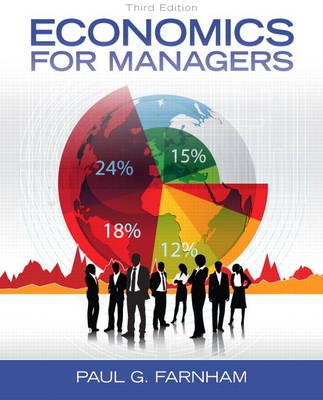
FUNDAMENTALS OF BUSINESS ECONOMICS
 |
| Spring 2017 |
 |
Graduate (S) Business Administration 509 FUNDAMENTALS OF BUSINESS ECONOMICS |
|
|
|
| | HOME | SYLLABUS | CALENDAR | ASSIGNMENTS | ABOUT PROF. GIN | |
Answers to Recommended Problems IChapter 2 1. Even though the question says to just deal with demand, it would be helpful if you did a complete supply and demand analysis for each event, including graphical analysis: a. Demand increases (assuming a normal good) => P increases, Q increases b. This is a movement along the demand curve for computers => decrease in quantity demanded c. Price of a complement decreases => demand increases => P increases, Q increases d. Decrease in the price of an input => supply increases => P decreases, Q increases e. Consumers expect price decrease => demand decreases => P decreases, Q decreases * * * * * * * * * * 2. Even though the question says to just deal with supply, it would be helpful if you did a complete supply and demand analysis for each event, including graphical analysis: a. Supply increases => P decreases, Q increases b. Increase in the price of an input => supply decreases => P increases, Q decreases c. This is a movement along the supply curve => decrease in quantity supplied d. Increase in the price of an input => supply decreases => P increases, Q decreases e. This affects demand => demand increases => P increases, Q increases * * * * * * * * * * 5. b. P = 120, Q = 260 c. P = 100 => QS = 200, QD = 300 => shortage of 100; competition among consumers would drive price up to the equilibrium price of 120 d. P = 150 => QS = 350, QD = 200 => surplus of 150; competition among producers would drive price down to the equilibrium price of 120 e. Increase in demand, new equilibrium is P = 140, Q = 320 * * * * * * * * * * 6. You should show the graphs of each of these a. PSubstitute increases => D increases => P increases, Q increases b. PInput increases => S decreases => P increases, Q decreases c. EXC increases => D increases => P increases, Q increases d. Technological improvement => S increases => P decreases, Q increases e. Negative change in tastes => D decreases => P decreases, Q decreases * * * * * * * * * * 7. You should show the graph of this a.
b.
* * * * * * * * * * 8. You should show the graph of this a.
b.
Chapter 3 1. a. ep = -1 => unit elastic b. ep = -5.4 => elastic c. ep = -0.54 => inelastic * * * * * * * * * * 3. a. Inelastic: P increase => TR increases b. Elastic: P decrease => TR increases c. Unit elastic: P increase => TR unchanged d. Perfectly inelastic: P increase => TR increases * * * * * * * * * * 5. The demand is price elastic, so consumers are very sensitive to price changes. The product is also a normal good that is a luxury (income elasticity is greater than one). Finally, the good is also a complement to the related good since the cross-price elasticity is negative. * * * * * * * * * * 6. See the answer on p. 474. Chapter 5 4. a. Accounting profit = 150,000 - (25,000 + 12,000 + 30,000 + 20,000) = 63,000 b. Economic profit = 150,000 - (50,000 + 5,000 + 25,000 + 12,000 + 30,000 + 20,000) = 8,000 Chapter 8 5. CR4 (A) = 30 + 25 + 10 + 5 = 70 CR4 (B) = 15 + 12 + 8 + 4 = 39 => Industry A is more concentrated * * * * * * * * * * 6. a. CR3 (C) = 25 + 25 + 25 = 75, CR4 (C) = 25 + 25 + 25 + 25 = 100, CR3 (D) = 80 + 10 + 5 = 95, CR4 (D) = 80 + 10 + 5 + 5 = 100 b. HHIC = 252 + 252 + 252 + 252 = 2500 HHID = 802 + 102 + 52 + 52 = 6550 c. Industry D is more concentrated because it has a higher CR3 and HHI. Chapter 9 2.
a. The dominant strategy for each firm is to price low. b. Both firms price low and make 100 each. c. This is a prisoners' dilemma because each firm follows their dominant strategy and end up worse off than if they had cooperated. Reading 2 5.
a. Network 2's dominant strategy is to put its big show first. Network 1 has no dominant strategy, but given what Network 2 is going to do, it will put its big show first as well.
b. If both networks use the maximin strategy, Network 1 will put its big show first, while Network 2 will do the same. c. d. It is credible because Network 1 has no dominant strategy. Putting its big show first is a distinct possibility. Network 2 will respond by putting its big show first as well. . |